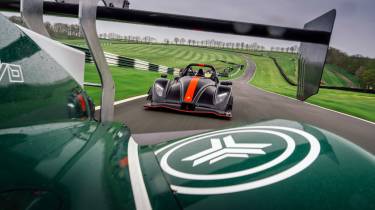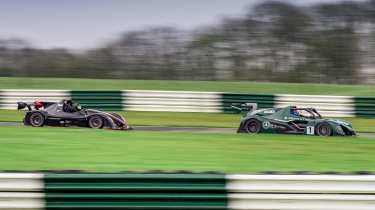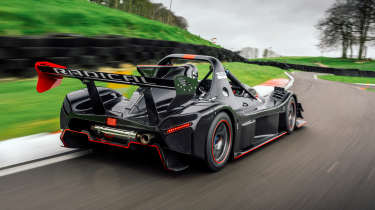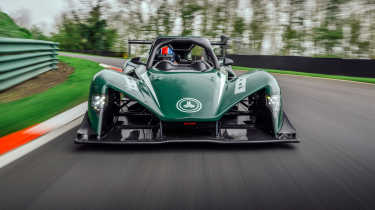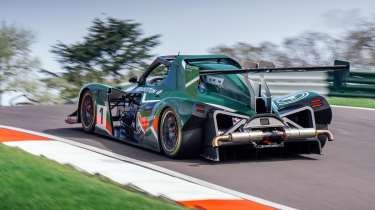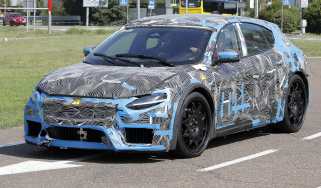Radical SR3 XXR v Revolution 500 Evo: downforce demons go head-to-head
There are no road car pretensions here: the Radical and Revolution sit where race car meets trackday car
It would be remiss to have a track car test without including two ultimate expressions of the genre. The Radical and Revolution are the only cars here that aren’t road-legal: they’ve been created purely for the track, for both racing and recreation, but they’ve also both been designed as cars that a novice or a seasoned driver could hop into and find equally rewarding. In short, they’re designed for fun as well as lap times, so they fit right in with this test’s ethos.
And as an ultimate benchmark for pure, focused driving, there’s little else out there like a Radical SR3. The SR3 has been around since 2002 and has evolved continuously since, with more than 1500 cars sold around the world, and multiple dedicated championships across various continents. But the essentials remain the same: lightweight tubular chassis, motorcycle-sourced engine (subsequently re-engineered by Radical’s RPE engine division), intelligently calibrated suspension, and aerodynamic bodywork shaped for downforce.
> Porsche 911 GT3 Manthey Racing v Spartan: £200,000 track toys battle it out
Here at Cadwell today, we have the SR3 XXR, the fifth-generation SR3, which launched in 2022. Together with solid-state data technology, it also features a new generation of RPE’s racing engine, available as either a 1340cc or 1500cc unit – this car has the latter. The first RPE engine with the ability to run on biofuel, it turns out 232bhp and runs through a six-speed paddleshift gearbox and Quaife limited-slip diff.
More reviews
Group tests
- Alpine A290 v Alpine A110 – how much DNA do they really share?
- Ariel Atom 4R v Caterham Seven ‘evo25’: power-to-weight heroes go head-to-head
- Caterham Super Seven 600 v Super Seven 2000
- Levante v T1
- Corvette Stingray v Porsche Cayman GTS v Audi R8 RWD
- Great Ferrari hypercars driven: 288 GTO, F40, F50 and Enzo head-to-head
- Hardcore Ferrari V8 specials go head-to-head
- Lamborghini Aventador Ultimae v Lamborghini Countach
- Lotus Emira v Morgan Plus Four – four-cylinder Brits go head-to-head
- Toyota GR86 v BBR Mazda MX-5: supercharged drop-top battles sports coupe
In-depth reviews
- Abarth 600e 2025 review – Italy gives the Alpine A290 something to worry about
- Alpine A110 review – distinctive, lightweight and unforgettable to drive
- Audi R8 (2015 - 2024) review – the ultimate soft-focus supercar
- Bentley Continental R Mulliner: review, history and specs
- BMW 5-series review – is this still Munich’s anchor model?
- BMW 1-series review – Munich’s Audi A3 rival gains focus
Long term tests
- Abarth 695C Turismo Fast Fleet test – 10,000 miles in the Italian hot hatch
- Alfa Romeo Giulia Veloce Fast Fleet test – 7000 miles in the sharp Italian saloon
- Alpina B10: end of term report
- Alpina B10
- Ford Mustang GT
- Ford Mustang GT
- Ford Mustang GT
- Land Rover Defender 110 Fast Fleet test – 9000 miles in the go-anywhere SUV
- Maserati Ghibli Trofeo Fast Fleet test – 4000 miles in the Ferrari-powered saloon
- Mitsubishi Evo MR 340
Review
- New Aston Martin DBS 770 Ultimate review – 759bhp super-GT driven
- New Bentley Batur 2023 review – can it possibly be worth £1.65m?
- 2023 Chevrolet Corvette C8 Z06 review – the American 911 GT3?
- Kia EV6 GT-Line S prototype review – the EV that shows how it’s done
- BBR Supercharged Mazda MX-5 (ND) 2023 review – tuned 250bhp roadster driven
- MG4 Trophy 2023 review
Reviews
- Abarth 695 75 Anniversario edition 2024 review – a fitting send-off for Abarth’s hot supermini?
- Abarth 500e 2023 review
- AC Cobra 378 Superblower MkIV 2021 review – another V8 Cobra, but with a GM heart this time
- Acura Integra Type S 2024 review – a Honda Civic Type R with added restraint
- Alfa Romeo Giulia 2025 review – get one while you still can
- Alfa Romeo SZ: history, review and specs of an icon
- Alfa Romeo 1750 TBi
- Alpina B3 GT Touring 2025 review – a 190mph alternative to the BMW M3 Touring
Stepping over the side and nestling down into the lay-back driving position, you’re reminded of another SR3 USP: an ant-level centre of gravity. Stepping into the SR3 after any of the road-legal cars gives you a totally different perspective.
In more ways than one. If some of the other cars here are about big straight-line speed, or managing and playing with their mass and balance through a corner, the Radical is about tiny braking zones and giant corner speed. With such low weight, low C of G, huge downforce and slick Hankook tyres, it takes a little time to recalibrate and understand just what it’s capable of.
The SR3 is actually one of the least powerful cars here, but on our scales it’s the second lightest after the Caterham, at 699kg – and that’s with a brimmed 77-litre tank! (For its lap times, it ran with between 30 and 40 litres.) Straight-line speed is not particularly startling. But the braking performance is on another plane. In places where many of the other cars are hard on the brakes, ABS chattering, in the SR3 you’re changing up a gear. No matter how late you think you can leave your braking, you can almost certainly go later.
And all accompanied by a shrieking, screaming engine note. Since it has its roots in a Suzuki bike engine, you need to keep the revs high to make the most of the in-line four-pot’s powerband. You live in the stratosphere in the SR3: up in the rarefied air of high revs and higher corner speeds. The precision you can operate it with, the sheer stability and confidence it gives you, is quite something. It feels as if the circuit and car are made for one another, so it’s not surprising that an SR3 once held the outright lap record at Cadwell.
‘I really enjoy the precision of the Radical,’ says Dickie after his stint. ‘It’s impervious to inertia: it’s all about carrying as much speed as you can. The other cars are all dominated by something, be it their engine, or a certain handling characteristic; the Radical is just a pure, polished thing. You’re not worried about wheelspin or a heavy engine behind you. It’s very linear in its power delivery and neutral in its handling balance. It has crystallised certain aspects of track driving. From braking point to exit point, it’s a weirdly calming experience…’
The menacing carbonfibre Revolution looks like it’ll be anything but calming. Wide and low, angular and angry in appearance, it’s a more serious-looking car. With more serious performance. Power – all 500bhp of it – comes from a Ford-sourced, Revolution-re-engineered and supercharged 3.5-litre V6. The Revolution 500 last featured in evo 311, when we experienced it in a race at Silverstone. Revolution has been busy since then, and the 500 is about to be superseded by the Revolution 500 Evo (good name). This is the first time anyone outside of the company has driven the 500 Evo prototype.
There are myriad detail changes over the previous 500 (so called for its power output; there is also a non-supercharged Revolution 427 model). One of those is a new gearbox able to withstand greater torque, so that’s been upped by 60lb ft to 410lb ft. Not that it felt puny exactly before. Torque delivery has been recalibrated with the supercharger gear ratio to be delivered from lower revs, while bigger, wider tyres help transmit it all to the tarmac, via a new adjustable differential. The rear suspension has been reworked to fit around the new gearbox and the front layout has been altered too, for more tuneability. The brakes have also grown in size, and there’s a new rear wing and aero package with more downforce and less drag. The power steering, too, has been overhauled for more tuneability and feel.
You can select how much or little power steering assistance you’d like via one of many switches on the F1-style steering wheel, along with traction control levels, engine mode and much more besides. Compared with the Radical – which also has an F1-style wheel with a digital display and data logging, but only one mode and no assistance – at first glance it all seems very complicated.
And yet it’s entirely user-friendly to drive. This car has the optional centrifugal clutch system, so it’s a two-pedal car to operate: no tricky racing clutch to stall in the pitlane. The traction control system reins in the V6’s torque spookily smoothly; over The Mountain you can keep your foot flat to the floor and feel it deftly turn the power down to quell wheelspin, then turn it up again like a fast-reacting dimmer switch.
More surprising still is how friendly its handling is. It’s a bigger, heavier car than the Radical – 981kg v 699kg as tested – and a very different one to drive. But the Revolution is truly agile. The new diff hooks up nicely out of Mansfield but enables quick direction changes through the twisties, and despite its intimidating sound (the V6 really growls, and there are all kinds of fascinating noises from the supercharger bypass valve) it’s a driveable, engaging machine at all speeds. ‘It’s a car you can really hustle – engaging and fun,’ says JB.
It is seriously, seriously fast though. Cadwell is often described as a mini-Nürburgring, and through the first, fast half of the lap, driving the Revolution 500 Evo feels a bit like watching the video of Timo Bernhard’s Porsche 919 Evo Nürburgring record lap: as if everything is on fast-forward, and using a one-corner, one-turn steering method with the massive downforce.
It’s no surprise that the Revolution clocks by far the fastest lap of the day (despite carrying a full, 90-litre tank of fuel). At 1:26.75 it’s more than four seconds quicker than the SR3 XXR in Dickie’s hands. In truth, these two are not direct competitors: in terms of lap times and performance, the Revolution aims to offer a more cost-effective alternative to Le Mans-style prototypes or high-end GT race cars. The SR3 can be raced in all kinds of series, though many competitors choose Radical’s own one-make Cup series; there are 12 currently running around the world. The 500 Evo costs £228,000 to the SR3 XXR’s £108,000. But in both cases many customers choose to buy them for pure recreation and trackdays rather than to go racing; for Revolution, it’s roughly a 50:50 split, and it’s similar for Radical globally.
The two are very different animals to drive. Dickie prefers the SR3’s precision and purity, but acknowledges that the 500 Evo’s configurable modes and engineering make-up mean it can do certain things the Radical can’t. JB, meanwhile, prefers the Revolution’s gritty V6 and its engagement at all speeds, even when you’re not leaning on the aero and going all-out.
For one more lap of Cadwell, I’d take the SR3. For one more lap of Silverstone, the Revolution. For one more lap in any of the cars in our 2024 evo Track Car of the Year test, that's a trickier question...
This story was first featured in evo issue 322.
